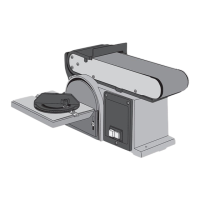3
ENGLISH
20. Inspect the tool for damage. Check the following before turning the tool on: that the guards and other
parts are undamaged and working properly, that moving parts can rotate freely and are correctly aligned,
that no moving parts can get caught, that there is no fault or defect that could affect the performance of
the machine. A safety guard or any other part that is damaged should be repaired by a tradesman or
replaced. Damaged power leads and switches must always be replaced by a tradesman.
Never operate a tool if you cannot stop or start the tool comfortably.
21. Use only recommended accessories. The use of non-recommended accessories can cause accidents
and personal injury.
22. Should only be repaired by a qualified technician. This tool conforms to current safety requirements.
Repairs to the tool should only be carried out by a tradesman using original spares; otherwise the tool
could cause accidents and personal injury.
23. Use a Residual Current Device on all 230 V power tools. This can help minimise the risk of an electric
shock if an earth fault or short circuit occurs. The product must not be modified or used for any other purpose
than that for which it has been designed. Regularly check that all screws and nuts are securely tightened.
1.2 Specific Safety Regulations for Belt Sanders
• Place the machine on a stable, level surface with plenty of room for manoeuvre.
• Think about how you are going to hold the workpiece during the entire sanding operation. Be wary of
kickbacks and injuries. The workpiece could catch in the sanding belt or disc and be ripped from your grasp.
• When using the sanding disc, always hold the workpiece against the side of the disc moving downwards
towards the table. If you sand against the upward side the workpiece can easily be ripped from your grasp.
• The distance between the belt/disc and work rest must never exceed 2 mm.
• To prevent the risk of fire: Keep the machine free of dust.
• Sparks produced when sanding metal can start fires. Prevent this by:
• Disconnecting any dust extractor suction hose that might be attached.
• First blowing off any dust particles on or in the machine.
• Removing any particles of metal before sanding wood again.
• Using the sander in a dry place, indoors and out of the rain. Make sure that the work area is well
illuminated.
• Position the sander in such a way neither the user nor any observer need stand in line with
the sanding belt or disc.
• Remove everything from the side table except the workpiece and the mitre guide.
• Avoid placing your hands in such a way that an accidental slip might cause a finger or hand to come into
contact with the abrasive surface. Keep your fingers well away from the opening to the dust extractor.
• Keep your face and as much of your body as possible out of range of possible kickbacks.
2. Product description
• Bench sander with fixed sanding disc and sanding belt which can be used horizontally or vertically.
Sanding disc: 150 mm Heavy-duty cast frame.
• Comes with adjustable sanding disc table and guide.
• Sanding belt: 100 × 915 mm, 8.5 m/s.
• Motor: 230 V/500 W. Fitted with NVR switch.
• Comes with adjustable side table (125 × 190 mm) and guide (0–45°).
• Size: 465 × 260 × 370 mm.
• Weight: 20 kg.

